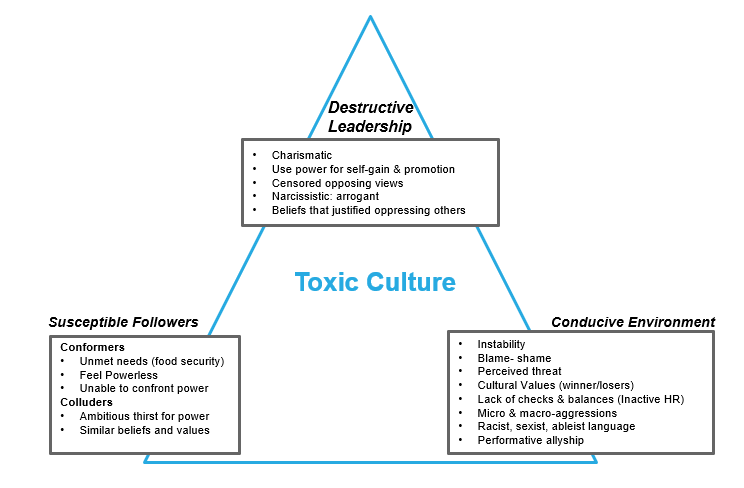
You may have heard that unless you heal and learn from bad relationships, you are likely to repeat the experience and engage with a new abuser. So, if you are part of the great resignation and are fed up with high workloads, low pay, and abuse, learn the pattern of destructive leaders before jumping into a new work relationship.
What do I mean by destructive leaders?
Destructive leaders are people you hear boasting loudly about their incredible abilities, or “humbly bragging” while using fear tactics to keep employees under their full control and sacrificing anyone that gets in the way of them gaining more power and prestige.
Perhaps you are still reeling from your experience one, thinking about how you ended up in such a toxic environment that promised to be an “inclusive company.” Let me assure you that it’s not easy to see the red flags while you are slowly being boiled alive. I know because I have experienced destructive leaders and their toxic cultures.
Several years ago, newly hired, I was super excited to join the new company. It took several months of “courtship” for my boss to finally make an offer. I happily accepted, and that’s when it all started. At first, my boss seemed to be a nice, agreeable person who made me feel like part of his team. It didn’t take long for me to see his other side; he was a micromanager who wanted to be copied on each email I sent. He spent most of his time finding the culprit for any mistake and blasting out emails to the entire office. There was a lot of secrecy, finger-pointing, and gossiping within the staff and it felt like there was a witch hunt for the worst performer. To top it off, our skip boss was suspicious of any person who in his mind would be stealing company time, so he would not allow people to work from home and would watch like a hawk for anyone leaving early.
Not long after joining, I found out that the person I replaced was fired, and there was a female clique that disapproved of the firing. Excluded from the water cooler conversations and lunch invitations, I felt like I was the middle school girl in the cafeteria with whom no one wanted to sit near. I did my best to try to fit in, but in reality, I was treated as an outsider and ended up eating lunch alone in my office while others went out together. It also became harder and harder to get the information I needed to effectively do my job. Trying to remedy the situation by asking one of the ring leaders for a chat backfired, with her yelling at me and I left in tears.
I decided to talk to my boss about the poor environment. He quickly blamed it on someone else who was just like him, on high alert for blame and deflection. My boss had created an atmosphere of fear and at the same time, he felt powerless to change it.
Within three months of my starting day, I began experiencing daily chest pains and dreaded coming to work. I walked on eggshells every day, not speaking up about what I was feeling or seeing, and was unable to perform at my best. At the time, I blamed myself, thinking I was not qualified after all to be a leader. I stuck around for almost a year until my health became compromised and I quit.
Destructive leaders create toxic cultures
What I didn’t know at the time is that I was working for a destructive leader. All the training I had on leadership never prepared me for surviving a toxic work environment or helped me identify the signs of a destructive leader.
Destructive leaders are generally charismatic, narcissistic by nature, and use their power for self-gain and promotion. He checked some of the boxes. These leaders exclude or punish those who speak up because silence allows them to retain power. They enjoy exerting power over others, so they control the team’s narrative and actions. Many know that they will have susceptible followers who will conform to their rules for fear of losing their livelihood. In retrospect, my fear and silence made me a supporter.
I believe at the heart of this toxic behavior is the leader’s blindness to the toxic side of power. In my experience assessing psychological safety in teams, I know that anyone can marginalize others to keep their perceived power. As I explained in my TEDx The Power of Inclusion, what these leaders don’t know is that holding power and being inclusive are not mutually exclusive.
Susceptible Followers
Many aspire to reach leadership levels and follow the same footsteps as their destructive leader thinking that this is the way to power. Two of my female co-workers displayed similar behaviors of micromanaging and blaming others. It was a toxic work environment but while I was there, I couldn’t label it. I just struggled with feeling like I didn’t belong.
After reading the article titled “The toxic triangle: Destructive leaders, susceptible followers,” I began to understand that my silence made me complicit. The secrecy at the office and public humiliation coupled with the lack of accountability for anyone’s bad behavior supported the status quo. I remembered seeing the dread in my co-worker’s faces, so we knew something was wrong but were unable to effectively change the existing culture.

The Environment
In toxic work environments, employees quickly learn that excluding those who speak up from high-power meetings and staying silent when witnessing microaggressions are acceptable forms of showing up. It’s called being a good “team player.” Also, some employees learn to engage in performative allyship, publicly speaking about all their Diversity & Inclusion efforts and privately sabotaging those they profess to protect. At these organizations, leaders use favoritism to promote employees.
In toxic cultures, you will find daily exclusion, racist interactions with hurtful language embedded in “jokes” and even sexual harassment. We know this because it’s not hard to find cases of black employees like Dena Simmons, a prominent researcher who quit due to bullying and racism, or Vivianne Castillo, a UX researcher who alleged experiencing daily microaggressions and gaslighting behaviors.
The Ugly Truth
You will likely also encounter a human resource system that fails to secure employees’ wellbeing and preoccupies itself with protecting the company from litigation. Those who commit the offenses can say, “It was not my intention to cause harm” and avoid suffering consequences for their behavior. It’s even likely that they are still employed at the company. So, before getting hired, research your potential manager to see if the person is attached to any discrimination lawsuits. If you are aware of any discrimination suits or complaints, ask the recruiter what changes were implemented to remedy the situation.
What keeps destructive leaders in power are susceptible followers, systems, and social norms that reinforce conforming rather than speaking up to keep a sense of team harmony. The energy an employee devotes to preserve this “fake” harmony prevents them from speaking up about the leader’s destructive behavior and effectively solving conflicts.
What can companies do?
Changing these dynamics is possible if we hold to account those who are destructive and examine the social norms and key players who influence the negative behaviors. Keep in mind that changing social norms is a marathon, not a sprint. Companies can also invest in training employees to effectively manage conflict and learn to be allies to speak up in support of those who are marginalized.
As you can see, the pattern includes not just your potential boss’s behavior but the teams who enable him/her/they and the organizational environment that supports the exclusionary norms. So, look for leaders who are transparent about power dynamics and hold accountable those who violate inclusion values. As always, it’s not always what they say, but what they do that counts.

Questions to identify Red Flags
When talking to the people interviewing you, ask them if they feel included, if they get invited to the meetings that matter, or how often they attend lunch with colleagues. Search online if those accused of discrimination are still employed in the team. Pay close attention to how you feel during the entire process to notice whether you are drained or energized.
Here are some questions that you can use to get a pulse of the team’s culture.
- How do you foster inclusion in the team?
- Tell me how you share your power with others?
- How much time is allocated for learning and development in the team?
- How is disagreement handled in the team?
- How many employees of color have been promoted in the last two years? And how many have left?
- When employees are micro-aggressed, how is it handled?
- How is toxic behavior addressed?
- What is the team’s attrition rate?
In conclusion, to land a job in a great culture, interview the leaders and team. Screen out roles where you hear about narcissistic behaviors in leaders, a lack of disagreement in the team, systems that don’t require accountability for bad behavior, and group norms that reinforce exclusion. Don’t get enamored by hollow diversity & inclusion language in job postings. Dig deeper and trust your gut, because it’s what will hurt every day if you land in a toxic culture.
Note: First posted on medium.
References
- Art Padilla et al 2007. The toxic triangle: Destructive leaders, susceptible followers, and conducive environments. The Leadership Quarterly 18 (2007) 176–194.
- Christina Bichieri. 2017. Norms in the wild. How to Diagnose, Measure, and Change Social Norms.
- Rebecca Knight. 2020. You’ve Been Called Out for a Microaggression. What Do You Do? Harvard business review.
- Ian Cook. 2021 Who Is Driving the Great Resignation? Harvard business review.

